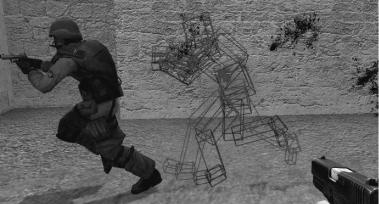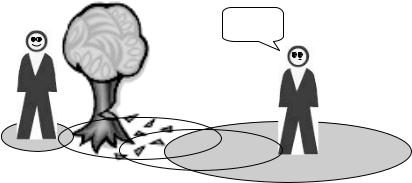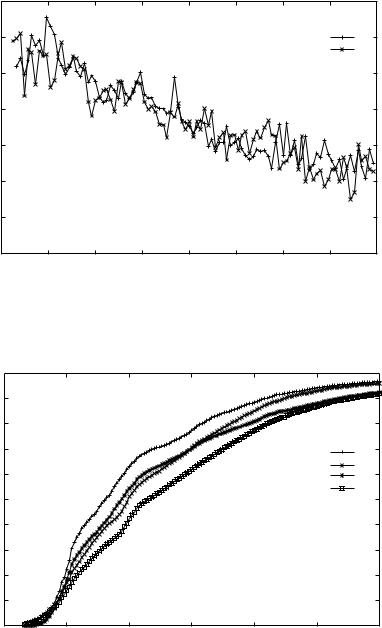
Название-Сеть в Играх 2006год_Язык-Eng
.pdf
94 Networking and Online Games: Understanding and Engineering Multiplayer Internet Games
Client 1 |
Client 2 |
Server processes |
command arrives |
command arrives |
both client commands |
Time
Time delay
Figure 6.8 Time Delay. A game server can hold client commands for a fixed amount of time, the time delay, before processing in order to compensate for clients with higher latency than others
clients themselves can use buffering to equalise the latency, with the client that is closer to the server delaying processing of the server state updates, while the client that is further away acting on the updates immediately upon receiving them.
Thus, buffering can provide fairness between clients with disparate latencies, but at the cost of making the gameplay less responsive. A related technique at the client is called interpolation, where a client has rendered the local world, but has a server update showing the position of units at a later time. Instead of immediately rendering the latest server world state, the client can interpolate the world at intermediate states, allowing the local world state to progress smoothly to the server world state. Another technique commonly used with interpolation is extrapolation where the world state at a future time is predicted. Extrapolation is, in fact, another form of prediction presented above.
In choosing a time delay buffer, it should be noted that users often prefer a consistent, even if large, delay, rather than a variable delay that jumps about widely. The effects of variable delays in terms of response time for interactive processes (e.g. Telnet or Internet phone) is well-known. In fact, Internet phone applications make use of time delay to explicitly avoid varying delays. Thus, the size of any time delay chosen should be adjusted infrequently (on the order of tens of seconds), even if the latency measurements from the server change more frequently.
6.3.2 Time Warp
A successful, widely used time manipulation mechanism is to have a server to rollback (or time warp) the events in a game to the time when a client command was inputed [Mau00, Valve]. The player provides input on the basis of the current state of the game at the client. Because of the lag between the client input and the server receiving the command, the state at the server may have changed. For example, the player shoots at an opponent at time t0, but by the time the message arrives at the server at time t2, the opponent had moved at time t1. Using time warp, the server rolls back the events it had processed since the client provided the input (roll back to time t0 in the above example). In this case, the server might determine that this older event has a bearing on subsequent events, changing their effect to make the global world state consistent. For example, the server may determine the player had hit and killed the opponent, meaning the opponent movement at time t2 was invalid.

Latency Compensation Techniques |
95 |
|
|
The general algorithm for the server is as follows:
•Receive packet from client
•Extract information (user input)
•Elapsed time = current time – latency to client
•Rollback all events in reverse order to current time – elapsed time
•Execute user command
•Repeat all events in order, updating any clients affected
•Repeat.
Note that for time warp to be effective, it requires an accurate measurement of the latency between a client and server in order that the game time can be rolled back the proper amount. Fortunately, the frequent message exchanges between server and client provide many opportunities for client–server latencies to be refined as the game is played.
By using time warp, clients that have a high latency to the server can still have their commands executed in the correct game-time order without impacting other players through a time delay. This allows players to respond to the current state of the game world without having to account for latencies to the server. For example, with time warp, a player in a first-person shooter can aim directly at an opponent, not having to worry about the opponent moving before the server gets the shot update message. Without time warp, in the same first-person shooter a player would have to ‘lead’ an opponent by aiming in front of them in order to hit the opponent when they did move.
The popular first person shooter game, Half-Life 2 (HL2), makes use of time warp [Valve] (along with some other techniques mentioned in this chapter). For testing purposes, the HL2 server allows additional lag to be added to the clients. The server administrator can observe the actual location of a unit and the location for the unit with time warp by having a separate client on the same machine as the server (a listen server). Figure 6.9 shows a screenshot of an HL2 listen server. The round-trip latency to the client is 200 ms, meaning the user’s commands are executed 100 ms before the screenshot. The
Figure 6.9 Example of Time Warp (Half-Life 2). The target is on the left and is ahead (in terms of time) of the client. The boxes on the right represent the targets the client had when shooting (back in time) and that the server uses when time is warped back to determine a hit

96 Networking and Online Games: Understanding and Engineering Multiplayer Internet Games
grey boxes show the target position on the client where it was 100 ms ago. Since then, the target moved to the left while the user’s command was travelling over the network to the server. When the user command arrives at the server, the server rolls back time (time warp) to put the target in the position it was at the time the user shot, indicated by the black boxes. The server determines there was a hit (the client sees blood from the wounds). Note that the client (grey) and server (black) boxes do not match precisely because of small differences in the time measurements and the speed of the moving target.
Time warp can cause some inconsistencies, however. Suppose a player places the crosshairs of a gun on an opponent and fires. The server, using time warp, will ultimately determine this is a “hit”. However, in the meantime, because of client–server latency, the opponent may have moved, perhaps even around a corner and out of sight. When the server warps time back to when the shot was fired and determines the opponent was shot, it will seem to the opponent that the bullets actually bent around the corner. Fortunately, this disconcerting effect is minimised if the opponent cannot see the attacker or if the opponent was still in the open and not hiding.
6.3.3 Data compression
While the propagation delay between a client and a server may be fixed (ultimately bounded by the speed of light), reducing the size of the messages sent between client and server can also reduce latency. As noted in Chapter 5, a small packet has a shorter transmission time than a large packet because of serialisation delay, a component of delay that accumulates at each router between the server and the client.
There are several ways that packet sizes can be reduced.
(a)Lossless Compression. Data can be manually compressed using well-known data algorithms. Unlike compression techniques for audio, video and images, compression for game data must be lossless, meaning all the bits that are compressed must be restored when uncompressed. Lossless data compression finds repeated patterns in the bits and compresses the repeats to use fewer bits. Most algorithms used for lossless compression are based on techniques developed by Lempel and Ziv in 1977 and later refined by Terry Welch’s 1984, and are hence called ‘LZW algorithms’ [Wel84].
(b)Opponent Prediction. As mentioned above, for some game units, opponent prediction can greatly reduce the amount of data that needs to be transmitted between game clients.
(c)Delta Compression. Rather than sending complete state information whenever there is a change to the world or its units, it may be possible to send updates as changes (or deltas) from the previous world. This technique requires reliable delivery of data (such as, by using TCP as the transport protocol), but can be effective when the entire game world update is large but the changes are small.
(d)Interest Management. Instead of sending all data to each client, only a subset of data, the data that is of interest to the client, can be sent [BGRP01, MBD00]. The area of interest for a client is called the aura and is where the interaction between the client and other game units occurs (Figure 6.10). Auras need not be symmetric, where the focus of one object needs to intersect the nimbus of another object in defining the aura. The goal of interest management is to reduce the number of messages needed to be sent to every client.

Latency Compensation Techniques |
97 |
|
|
Where are you?
Hider’s |
Hider’s |
|
|
nimbus |
Seeker’s |
|
|
|
focus |
|
|
|
|
focus |
Seeker’s |
|
|
|
|
|
|
|
nimbus |
Figure 6.10 Aura of interest, illustrated by the game ‘Hide and Seek.’ The Aura is made up of a Focus and Nimbus. If the Focus of a unit intersects the Nimbus of another unit, they can interact. Here, the Hider can see the Seeker, but the Seeker cannot see the Hider
(e)Peer-to-Peer. Using a peer-to-peer network where clients send data directly to each other rather than to the server can reduce bitrates to the server. Peer-to-peer architectures are used for some common game aspects, such as voice chat during a game, but can be extended to include all non-essential game aspects (e.g. players could customise their avatar appearance, sending these appearances only changes directly to other peers).
(f)Update Aggregation. Sending updates after some periodic delay can avoid some of the network overhead associated with each message. For example, if player A moves at
time t0 and player B moves at time t1, rather than send two messages to player C, the server may choose to send one, slightly larger message at time t1 containing the moves for A and B, thus avoiding the network overhead for packing and sending an additional message. In some cases, update aggregation can even reduce the number of messages sent. For example, if A turns an avatar to face left and then turns to face right, the server may choose to elide the commands and send only the latest facing to the right to other clients.
In general, using compression trades off CPU cycles at the client and server for reduced network load. If the network reduction is significant, and the compression and decompression is not computationally prohibitive, compression makes sense as a latency compensation technique.
6.4 Visual Tricks
This section mentions a few techniques that do not really involve networking, but can cover up network latency to the user.
A start-up animation can be used to hide latency from the client to the server. For example, if a boat gets ready to move, the game may require it to visually raise sails before it starts to actually move. Such animation delays can take a couple of hundred milliseconds, even allowing a message to go the server and back before the unit actually moves. This way, if the server indicates the move is not allowed (perhaps another boat is

98 Networking and Online Games: Understanding and Engineering Multiplayer Internet Games
blocking the way), there is no discrepancy to fix, while the player still receives immediate feedback making the game feel responsive.
Similarly, local confirmation can be used immediately even if the remote effect is not confirmed by the server. For example, if a player pulls the trigger on a gun, the game client can play a shooting sound effect and show a puff of smoke, even if the impact of the shot is not determined for some time.
6.5 Latency Compensation and Cheating
Unfortunately, the anonymity that the Internet provides often promotes behaviour that would not occur offline. For online games, this often means the propensity for cheating. Some of the latency compensation techniques, while attractive for helping gameplay by reducing the effects of Internet latency, provide new opportunities for cheating.
It may occur to the astute reader that using opponent prediction could eliminate the need for a server completely. Each client could compute their own actions and send the needed updates to the other clients when there is a change. In fact, this model of clientside communication only is the one proposed in DARPA’s DIS protocol and works quite well if the clients can be trusted. However, for many game conditions, especially online, multiplayer games where players do not know one another, pure-client control of the game world state is prone to cheating. For example, a client could just send a message to another client saying ‘my player is right behind your player and just shot you in the head’. Without an authoritative server to confirm or refute such client actions, some games would suffer from rampant cheating.
With time warp, a client could interfere with measurements about round-trip time, making the server believe the client is further away than it actually is. This would allow the client to respond to events that, in essence, happened in the past and hence giving unfair advantage. Similarly, with time delay, a client with slow reflexes could claim a higher latency than it actually has, causing a large time delay at the server, thus neutralising the better reflexes that opponents may have. Opportunity to cheat with these time manipulations are exacerbated if the client controls the timing measurements and time delays.
Interest management, while reducing network bitrates, can also be abused by cheaters. Clients can claim interest in game state that they could otherwise not see, using this information to gain a tactical advantage. For example, in a strategy game, a client could freely scan the other side of the map, locating the opponents base and attacking when the base should be concealed by the ‘fog of war’. Or, in a shooter game, a player could observe an opponent on the other side of the wall, when the opponent should be concealed.
References
[AB05] S. Aggarwal and H. Banavar, “Fairness in Dead-Reckoning Based Distributed Multi-Player Games”, In Proceedings of the 4th ACM Network and System Support for Games (NetGames), Hawthorne, NY, USA, October 2005.
[BGRP01] S. Benford, C. Greenhalgh, T. Rodden, and J. Pycock, “Collaborative virtual environments”, Communications of the ACM, Vol. 44, No. 7, pp. 79–85, 2001.
[CF05] A. Chandler, J. Finney, “On the Effects of Loose Causal Consistency in Mobile Multiplayer Games”, In Proceedings of the 4th ACM Network and System Support for Games (NetGames), Hawthorne, NY, USA, October 2005.

Latency Compensation Techniques |
99 |
|
|
[CLC99] W. Cai, F. Lee, L. Chen, “An Auto-Adaptive Dead Reckoning Algorithm for Distributed Interactive Simulation”, In Proceedings of the 13th ACM Workshop on Parallel and Distributed Simulation, Atlanta, Georgia, USA, Pages: 82–89, 1999.
[Dead reckoning] Wikipedia, “Dead Reckoning”, [Online] http://en.wikipedia.org/wiki/Dead reckoning, Accessed 2006.
[DF98] C. Durbach and J.M. Fourneau, “Performance Evaluation of a Dead Reckoning Mechanism”, Proceedings of the Second International Workshop on Distributed Interactive Simulation and Real-Time Applications, page 23, July 19–20, 1998.
[DIS] Wikipedia, “Distributed Interactive Simulation”, [Online] http://en.wikipedia.org/wiki/Distributed Interactive Simulation, Accessed 2006.
[Mau00] M. Mauve, “How to Keep a Dead Man from Shooting”, Proceedings of the 7th International Workshop on Interactive Distributed Multimedia Systems and Telecommunication Services (IDMS), 2000, pages 199–204, Enschede, Netherlands, October 2000.
[MBD00] K.L. Morse, L. Bic, and M. Dillencourt, “Interest Management in Large-Scale Virtual Environments”, Presence, Vol. 9, No. 1, pp. 52–68, 2000.
[Ney97] D.L. Neyland, “Virtual Combat: A Guide to Distributed Interactive Simulation”, Stackpole Books, Mechanicsburg, PA, 1997.
[Wel84] T.A. Welch, “A Technique for High Performance Data Compression”, IEEE Computer, Vol. 17, No. 6, pp. 8–19, 1984.
[Valve] Valve Developer Community, “Source Multiplayer Networking”, [Online] http://developer. valvesoftware.com/wiki/Source Multiplayer Networking, Accessed 2006.

7
Playability versus Network Conditions and Cheats
Ultimately, a game hosting company, an Internet Service Provider (ISP) and a game manufacturer are aiming for the same thing – satisfied consumers. Satisfaction is achieved by understanding, and avoiding, the circumstances that would undermine an enjoyable game-play experience.
In this chapter we look at methods people have used to measure and infer player tolerance for network issues (such as latency, loss and jitter). We also look at how network communication models impact on cheats and cheat-mitigation techniques available to game developers.
7.1 Measuring Player Tolerance for Network Disruptions
Quantifying the typical player reaction to network-level characteristics is a nontrivial task. Everyone knows that ‘latency is bad for gaming’. The task for ISPs and game hosting companies is to determine just how much latency becomes noticeably ‘bad’ for some definitions of bad, and to develop similar insights for loss and jitter as well.
A player’s sense of satisfaction with any particular game will usually depend on a range of environmental factors. Players may be more or less judgemental of network-induced game-play disruptions if they are tired, hungry or have pre-existing social relationships with other players on the server. Any technique for inferring a relationship between player satisfaction and network conditions must consider these other influences.
There are two distinct approaches for discovering player tolerance to network disruptions.
•Build a controlled lab environment in which to test small groups of players under selected conditions
•Monitor player behaviour on public servers over many thousands of games.
Controlled usability trials are preferable whenever possible. One can monitor (and later account for) tiredness, hunger and social relationships between players. Arbitrary and repeatable network-level latency, loss and jitter between the players and the game server are introduced artificially. By varying the network conditions and keeping other
Networking and Online Games: Understanding and Engineering Multiplayer Internet Games
Grenville Armitage, Mark Claypool, Philip Branch 2006 John Wiley & Sons, Ltd

102 Networking and Online Games: Understanding and Engineering Multiplayer Internet Games
environmental conditions steady, we can draw fairly solid conclusions about player tolerances from modestly small groups of players.
Unfortunately, it is often hard to find a set of people willing to sit and play in a controlled lab environment, let alone actually obtain the resources to create the lab, in the first place. The alternative is to correlate user behaviour on an existing game server with changes in network conditions over time. This approach is less than ideal, because we cannot control (or even know) the environmental factors affecting every player who joins our server. We cannot control the precise network conditions affecting each and every player. At best we can wave our hands around and invoke the ‘law of large numbers’ – make measurements over thousands of games, correlate player success with known network conditions and hope the remaining unknown factors cancel themselves out.
Defining a metric for player satisfaction can also be problematic. In controlled trials, every player can be asked to fill out a survey form after each game, allowing selfreporting of subjective ‘satisfaction’. When running a public game server it is far harder to entice players into filling out your survey. Unless the game’s developer integrates a survey mechanism into the game itself, you are asking players to make a special, separate visit to your web site after playing on your server [OLI2003]. In all cases, care must be taken to provide questions that discover a player’s environmental circumstances and avoid questions that bias player’s answers.
Another approach is to track objective in-game measures of success, for example, the ‘frag’ (kill) rate of players on a First Person Shooter (FPS) game. This can usually be done equally well with both controlled lab trials and public servers, since the information will be contained in the server’s own log files.
7.1.1 Empirical Research
Over the past few years, a number of empirical trials have been run using public servers – here we will touch on work done with games such as Quake III Arena, Half-Life, Unreal Tournament 2003 and Warcraft III.
In 2001, two Quake III Arena servers were established with identical map cycles, identically limited to six players at a time, had two ‘bots’ at all times, and virtually identical ‘server names’ visible to the public [ARM2001, ARM2003]. They differed only in that one was located in Palo Alto, California (USA) and the other was located at University College London, London (UK). The Californian server ran from May 17 to August 18, 2001 and saw 5290 unique clients who accumulated a total of 164 ‘days played’. Of the 5290 clients, 338 clients each accumulated more than 2 hours total playing time during this period. The London server ran from May 29 to September 12, 2001 and saw 4232 unique clients who accumulated a total of 77 ‘days played’. Of the 4232 clients, 131 clients each accumulated more than 2 hours total playing time during this period.
Figure 7.1 illustrates the impact of a player’s median latency (ping) on their average ‘frag rate’. Since games run for many minutes, a fractional improvement on your frag rate can make quite a difference in your ranking relative to other players.
Another perspective on latency is provided by Figure 7.2. This shows, as a cumulative histogram, the number of games played by clients who experienced a particular median latency throughout their game. A somewhat tenuous argument can be made that players come back more frequently if the latency is tolerable, hence the drop off from

Playability versus Network Conditions and Cheats |
103 |
|
|
Frag rate as a function of player’s median latency (Quake III Arena in 2001)
|
3.5 |
|
|
|
|
|
|
|
|
|
3 |
|
|
|
|
|
Palo Alto server |
|
|
|
|
|
|
|
|
|
London server |
|
|
|
2.5 |
|
|
|
|
|
|
|
|
per minute |
2 |
|
|
|
|
|
|
|
|
|
|
|
|
|
|
|
|
|
|
Frags |
1.5 |
|
|
|
|
|
|
|
|
|
|
|
|
|
|
|
|
|
|
|
1 |
|
|
|
|
|
|
|
|
|
0.5 |
|
|
|
|
|
|
|
|
|
0 |
|
|
|
|
|
|
|
|
|
0 |
50 |
100 |
150 |
200 |
250 |
300 |
350 |
400 |
Median ping (milliseconds)
Figure 7.1 Frag rate as a function of median latency (Quake III Arena in 2001)
Distribution of played games as a function of experienced median latency (Quake III Arena in 2001)
|
100 |
|
|
|
|
|
|
|
90 |
|
|
|
|
|
|
|
80 |
|
|
|
|
|
|
(%) |
70 |
|
|
|
Palo Alto (active) |
|
|
60 |
|
|
|
London (active) |
|
||
|
|
|
|
Palo Alto (all) |
|
||
games |
|
|
|
|
|
||
50 |
|
|
|
|
London (all) |
|
|
|
|
|
|
|
|
||
|
|
|
|
|
|
|
|
Played |
40 |
|
|
|
|
|
|
30 |
|
|
|
|
|
|
|
|
|
|
|
|
|
|
|
|
20 |
|
|
|
|
|
|
|
10 |
|
|
|
|
|
|
|
0 |
|
|
|
|
|
|
|
0 |
50 |
100 |
150 |
200 |
250 |
300 |
Median ping (milliseconds)
Figure 7.2 Percentage of ‘played games’ as a function of median latency (Quake III Arena in
2001)
